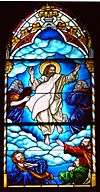Healing the man blind from birth

Jesus performed the miracle of healing the man born blind as recorded in the Gospel of John, 9:1-12.[1]
According to the Gospel, Jesus saw a man who had been blind since birth. His disciples asked him, "Rabbi, who sinned, this man or his parents, that he was born blind?"
Jesus replied:
"Neither this man nor his parents sinned," said Jesus, "but this happened so that the works of God might be displayed in him. As long as it is day, we must do the works of him who sent me. Night is coming, when no one can work. While I am in the world, I am the light of the world."
Having said this, he spat on the ground, made some mud with the saliva, and put it on the man's eyes. "Go," he told him, "wash in the Pool of Siloam" (this word means "Sent"). So the man went and washed, and came home seeing.
His neighbors and those who had formerly seen him begging asked, "Isn't this the same man who used to sit and beg?" Some claimed that he was. Others said, "No, he only looks like him." But he himself insisted, "I am the man."
"How then were your eyes opened?" they asked. He replied, "The man they call Jesus made some mud and put it on my eyes. He told me to go to Siloam and wash. So I went and washed, and then I could see."
"Where is this man?" they asked him. "I don't know," he said.
In this miracle, Jesus applies the title Light of the World to himself in John 9:5, saying:[2]
- When I am in the world, I am the Light of the World.
This episode leads into John 9:39 where Jesus metaphorically explains that he came to this world, so that the blind may see.[2]
According to Christian tradition, the man's name was Celidonius.
See also
- John 9
- Life of Jesus in the New Testament
- Ministry of Jesus
- Parables of Jesus
- Light of the World
- Seven signs in the Gospel of John
References
- ↑ Biblegateway John 9:1-12
- 1 2 Matera, Frank J. New Testament Christology. Louisville, Ky. : Westminster John Knox Press, 1999, 235.
